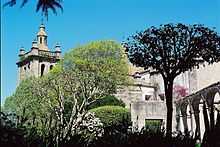Miranda do Douro


Miranda do Douro (Portuguese: [miˈɾɐ̃dɐ ðu ˈðowɾu]) or Miranda de l Douro (Mirandese: [miˈɾãdɐ ðɨɫ ˈðawɾu]) is a city in Miranda do Douro Municipality, district of Bragança, Portugal.
The city has a population of 1,960.[1]
General information
The municipality is composed of 17 parishes, and is located in the northeastern part of the country, in the district of Bragança.
The present mayor is Manuel Rodrigo Martins (Social Democrat) and the president of the Municipal Assembly is Domingos Duarte Lima (Social Democrat). The municipal holiday is on July 10.
The river is one of the main attractions of this small city. There are organized trips to watch the wildlife, mostly birds of prey. Important hydro-electrical stations exist in the municipality.
The city itself is quite small. The city is also surrounded by many smaller villages, which surround the city at almost all angles. Most inhabitants of Miranda do Douro are either merchants or farmers. As Miranda do Douro is quite small, population wise. Most of its economical growth is dependent on the summer months, when most tourists come to see the city.
Most tourists are of Spanish origin as Spain is very close to Miranda do Douro. Other tourists that come to the city during the summer can also be of French origin or North American. Other tourists that come to the city during the summer month tend to be people who grew up within the area and enjoy coming back every summer be it to see family or just vacation in the small and quaint city.
History
The origin of Miranda do Douro as a populated place is still discussed by historians, but archeologist discoveries give evidence that inhabitants have been living there during the Bronze Age. It is known that it was an important city during the Roman age. They give it the name of Cuntium, Paramica, Sponcia and even Cambetum Lubicanarum.
The city is located on the border with Spain, with the Douro River separating the two countries. The nearest town in Spain is Zamora, site of the Treaty of Zamora (1143) between the Portuguese king Afonso I and the Leonese king Alfonso VII. This marked the recognition of the independence of the Kingdom of Portugal, proclaimed in 1139.
The nearest railway station, Duas Igrejas - Miranda, was the station for Miranda do Douro but was located several kilometres away. This station was the northern terminus of the narrow gauge Sabor line, connecting with main line trains to Oporto at Pocinho. The station was opened in 1938, but closed in 1988.
Culture
The city has been isolated from the rest of the country for many centuries, so the ancestral way of life is still vivid in the traditions and even in the language (see below). Apart from the distance, the weather conditions are also an adversary, as it is very cold and snowy in winter, and very dry and hot in summer.
Gastronomy is one of the local hallmarks, well within the tradition of Trás-os Montes. "Posta à Mirandesa", a heavy, thick steak, is the traditional dish, known and imitated through the rest of the country. The wine from the region has a high alcoholic graduation (17–18°) and matches the regional cuisine well.
The city's old quarter, with the cathedral, dates back to the Middle Ages. Most houses are small and one story high. Inside the old city proper lie the town hall and museum, the "Museu da Terra de Miranda" (museum of the lands of Miranda), which has displays of archaeological findings, farm life, local clothing, and traditional masks.
The city has no industries but depends on commercial activity, mainly the sale of house textiles and cutlery from the village of Palaçoulo. Spaniards come in great number on holidays and weekends. There are several hotels, among them the Pousada de Santa Catarina, which overlooks the Douro River.
Mirandese language

The surrounding area is home to the speakers of Mirandese (Mirandês), a language of the Astur-Leonese family, related to Asturian and Leonese.[2] Mirandese was recognised in 1999 by the Portuguese state as co-official with Portuguese for local matters, and an estimate of between 10,000 and 15,000 people speak the language.[3]
Sister city
See also
- Kingdom of León
- Leonese language
- Planalto Mirandes IPR
- Terra de Miranda
| Wikimedia Commons has media related to Miranda do Douro. |
References
- ↑ "?".
- ↑ "UNESCO".
- ↑ http://www10.gencat.net/pres_casa_llengues/AppJava/frontend/llengues_detall.jsp?id=43&idioma=5
External links
- City government official website
- Photos from Miranda do Douro
- Pauliteiros de Miranda Mirandese culture (in Portuguese)
Coordinates: 41°29′49″N 6°16′23″W / 41.497°N 6.273°W